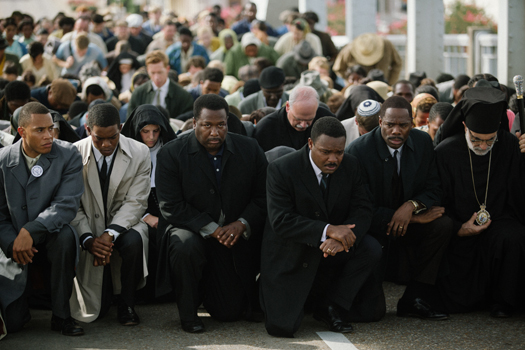We have . . . overcome.
Swift shot: Selma is a two-hour education on civil rights and the struggle for equality that southern blacks faced in the 1960s. But, those that claim we haven’t come very far are intellectually inept. In the 1860s the struggle began in earnest, and 100 years later, there was indeed progress, but hardly equality. Now, it is 2015, some 50 years after MLK Jr. crusaded for equality. We have come much further. If you don’t agree, that’s fine. But, give me factual examples of the types of hostile racism prevalent then, now. I’ve said it many times on Twitter, I abhor ALL racism! My dream is to one day see the “race” box eliminated from ALL forms and applications. Until that happens, we won’t have true equality. Off my soap box . . . now onto Selma.
This is not the life story of Dr. Martin Luther King, Jr. This is one small chapter in his greater war on racism, the systematically approved banality of our hypocritical past. David Oyelowo plays the eternally young pastor, Dr. King, with enough passion to get emotional responses from the audience. I didn’t really feel he became King though, until the very end of the film. I wanted to connect with him, because Dr. Martin Luther King, Jr. has always fascinated me. I admire him. His ability to employ non-violence against people that you clearly want to hurt takes the utmost of discipline and faith. Few possess that kind of mettle.
Selma is slow and develops like a love letter to those who did “Overcome” in the 60s, to the folks that marched with the Doctor. Selma is their story. Several key players are present throughout the film, as Oprah essentially starts out the film as the terrified, but brave Annie Lee Cooper. She had the audacity to register to vote in her county. At one point, the clerk asks her the most ridiculous questions, which portrays true voter repression. This cannot stand, and Dr. King manages an audience with President LBJ (Tom Wilkinson), who is waging a war on poverty, not really racism. But he’s just passed the Civil Rights Act of 1964. LBJ is pretty proud of that legislation, and he can’t really come to terms with how impatient Dr. King is being about the south. It’s almost as if there are two countries present in the film. This is a concept that few today will understand, and I hope they never fully do grasp that concept. Truly, we were on the verge of fighting another civil war – yes, it was that close!
Alabama Governor George Wallace (Tim Roth) and the County Sheriff, Jim Clark (Stan Houston) have made it clear that blacks aren’t getting the vote. The lines in the sand have been drawn, and the march for equality will begin in Selma, Alabama. The nation is outraged at a horrific church bombing that killed little girls preparing for communion in Birmingham, but the killers are not being brought to justice. There is no justice. It’s here that the best actor in the film captured my attention, Trai Byers as James Forman, a Student Non-Violent leader that is chagrined with Dr. King’s presence in Alabama. Byers was unknown to me before the film, and this guy encapsulates the old adage there are no small parts. I think Byers will be around a long time.
Where Selma struggles a bit is the element of assumption prevalent throughout. Simply having someone on screen doesn’t elicit an emotional response, and it does come . . . again, at the end, as the players each have their fates exposed for the audience. It makes for a nice dramatic effect, but we needed that connection throughout the film, and it just wasn’t there. For example, it was like picking up a book and reading the middle chapters. There needs to be a bit more exposition to really grab the audience, at least the audience not devoutly familiar with all the players of the Civil Rights movement.
The timing of this film is eerie, as well, as we face racial tension across the nation. Watching LBJ weakly balance his power and ineptness at the situation makes Selma almost a companion piece to Lincoln. The two films juxtapose the crescendo of equality that is the Movement. Both are historically significant, and both may suffer from a tedious nature at times but they need to be watched. People who are afraid of the past, may find Selma difficult to watch, but that’s the point. Selma was where everything came to a head, on a bridge, the perfect metaphor for crossing a racial divide in America. Don’t see Selma, if you aren’t ready to face the past. See it if you want to understand how far we’ve come . . . together as these United States of America.




